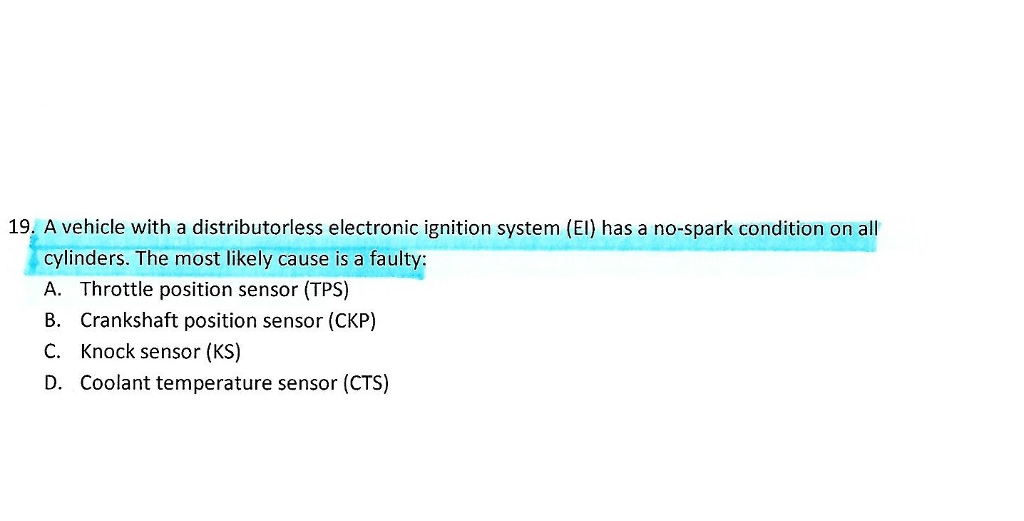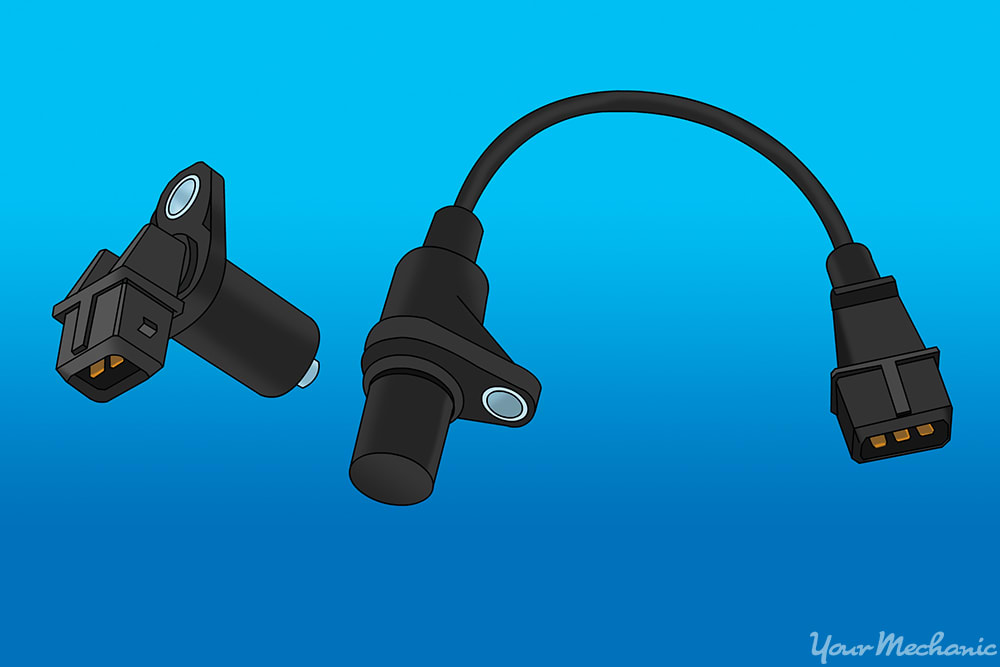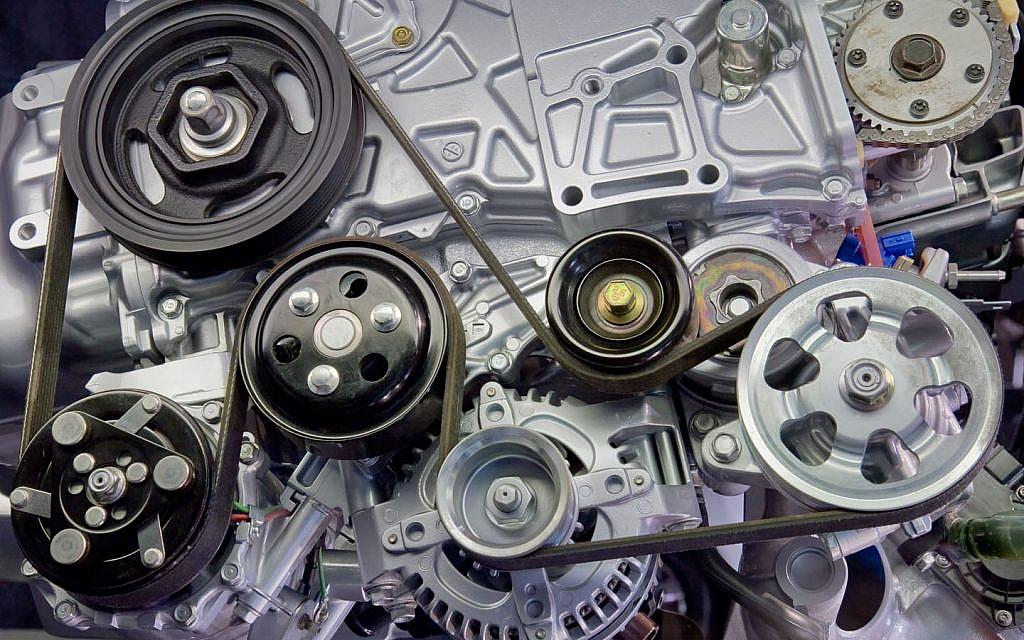Can a Knock Sensor Cause No Spark
A faulty knock sensor typically does not cause a no-spark condition. It mainly affects the ignition timing and engine performance.
Understanding the role of a knock sensor in a vehicle’s engine management system is essential for diagnosing problems. The knock sensor detects abnormal vibrations, known as ‘knocking’, which can indicate improper combustion within the engine. This sensor sends signals to the Engine Control Unit (ECU), enabling it to protect the engine by adjusting the ignition timing.
While a failing knock sensor can lead to a reduction in engine power, poor fuel economy, and increased emissions, it is not directly responsible for the ignition system creating spark. Generally, no-spark issues stem from problems with spark plugs, ignition coils, or electrical connections. For vehicle owners and mechanics, identifying and remedying the true source of a no-spark condition is key to restoring engine function.

Credit: www.chegg.com
The Role Of A Knock Sensor In Engine Management
The knock sensor plays a vital role in engine management. This sensor’s primary purpose is to detect engine knock, also known as detonation or pre-ignition, which can cause significant damage to the engine. It ensures smooth engine operation and helps to optimize performance and efficiency.
Typical Functions Of A Knock Sensor
The knock sensor has several important functions within the engine management system:
- Detects irregular vibrations indicating knock.
- Converts these vibrations into electrical signals.
- Sends signals to the engine control unit (ECU).
- Helps to prevent potential engine damage.
How The Knock Sensor Affects Ignition Timing
Ignition timing is critical for engine performance. The knock sensor influences the ECU’s decisions on when to spark the ignition. Improved ignition timing leads to better fuel efficiency and power. A faulty sensor can disrupt this process. However, it typically does not cause a total lack of spark.
Here’s how a properly functioning knock sensor helps:
- It detects adverse combustion events.
- Communicates with the ECU in real-time.
- ECU adjusts timing to prevent engine knock.
In conclusion, while the knock sensor has a critical role in managing the ignition timing to prevent damage, it’s not usually responsible for causing no spark situations in an engine.
Understanding No Spark Condition
An engine’s failure to start often points to a No Spark Condition. This is when the ignition system fails to deliver an electrical spark to ignite the fuel mixture in the combustion chamber. The absence of spark halts the engine’s ability to operate.
Symptoms Indicating a No Spark ScenarioSymptoms Indicating A No Spark Scenario
- Engine Won’t Start: When the key turns, but the engine doesn’t fire up.
- Stalling: The vehicle suddenly stops while running.
- Misfiring: The engine skips over or struggles to power through.
Common Causes For No Spark
A variety of issues can lead to a No Spark Condition:
| Component | Function | Effect When Faulty |
|---|---|---|
| Ignition Coil | Generates high-voltage for spark | No high-voltage, no spark |
| Distributor Cap and Rotor | Conveys spark to spark plugs | Improper distribution of spark |
| Spark Plug or Wire | Delivers spark to cylinder | Lack of spark, engine misfires |
| Crankshaft Position Sensor | Monitors engine’s rotation speed | Incorrect timing or no spark |
| Knock Sensor | Detects engine knocking | Can improperly retard timing, rarely causing no spark |
A knock sensor doesn’t typically cause No Spark directly. However, it can lead to other malfunctions that might indirectly prevent spark generation.
Interplay Between Knock Sensor And Ignition System
Understanding the connection between the knock sensor and the ignition system is crucial for engine performance. This sensor plays a key role in preventing engine damage. Ignition timing adjustments rely on the knock sensor’s accuracy. Even a small hiccup can cause big issues.
Impact Of Knock Sensor Signals On Engine Ignition
Proper communication from the knock sensor is vital for smooth engine ignition. This sensor detects engine pings or knocks. It sends a signal to the Engine Control Unit (ECU). The ECU then adjusts the ignition timing. This prevents engine damage. A faulty knock sensor can mislead the ECU. The result? Potential misfires and no spark situations.
- Kickstarts the Ignition Process: By detecting knocks, it signals the ECU to work.
- Prevents Misfires: Helps in avoiding incorrect engine timing.
- Protects the Engine: Adjusts timing to avoid engine knock damage.
Electrical Interference And Miscommunication
Electrical interference can lead to miscommunications between the knock sensor and the ECU. Wires can cross-talk. Other electronic signals can interfere. This confusion can disrupt the ignition system. It can trick the ECU into wrong decisions. Faulty wires or a bad sensor can be the culprits.
Regular checks can prevent such issues. A mechanic will look for:
- Damaged knock sensor wiring
- Corroded sensor connectors
- Other electronic interference sources
Always ensure the knock sensor functions properly. It is critical for a spark-healthy ignition system.

Credit: www.aa1car.com
Diagnosing Knock Sensor Related Issues
Dealing with car troubles can be puzzling, and understanding how components like a knock sensor might affect your engine’s spark is crucial. Diagnosing knock sensor related issues plays a vital role in ensuring your car runs smoothly. Let’s dive into how you can analyze and troubleshoot potential problems caused by a malfunctioning knock sensor.
Analyzing Trouble Codes And Engine Performance
Faults in your car’s systems often trigger check engine lights and specific trouble codes. A professional diagnostic tool or OBD-II scanner reads these codes. Codes related to the knock sensor, such as P0325 or P0330, typically emerge when it is not performing well. It’s essential to understand what these codes mean:
- P0325 – Knock Sensor Circuit Malfunction
- P0330 – Knock Sensor 2 Circuit Malfunction (Bank 2)
When a knock sensor fails, the engine’s timing can be off. This incorrect timing might prevent the spark plugs from igniting the air-fuel mixture at the right time, potentially leading to no spark or misfires.
Troubleshooting Steps For Knock Sensor Problems
Addressing issues with the knock sensor involves several steps:
- Perform a visual check for any damaged wiring or connections.
- Measure the resistance and voltage of the knock sensor to confirm it’s within the specified range.
- Inspect the engine block where the sensor is located; ensure it’s clean and well-grounded.
- Use an automotive stethoscope to listen for actual engine knocks which can indicate sensor accuracy.
If these steps reveal a faulty knock sensor, replacement may be necessary. Always follow the vehicle’s service manual to conduct accurate and safe repairs. Remember, while a knock sensor might not directly cause no spark, its failure can impact overall engine performance, leading to spark issues.
Rectifying No Spark Issues
Car engines require a delicate balance of air, fuel, and spark to run smoothly. A missing spark leads to engine troubles. Discover common spark issues and learn how to fix them.
Replacing A Faulty Knock Sensor
The knock sensor detects engine knock or pinging. A bad knock sensor might mess with engine timing. This can prevent spark production. Follow these steps for replacement:
- Locate the knock sensor on your engine block.
- Disconnect the sensor’s electrical connector.
- Unscrew the old sensor.
- Screw in the new sensor by hand, then tighten with a wrench.
- Reconnect the electrical connector.
Addressing Spark Plug And Coil Problems
Spark plugs and coils are vital for a proper spark. They need checking too. Follow the steps below:
- Inspect Spark Plugs:
-
- Remove and examine each plug.
- Look for damage, deposits, or wear.
- Replace if necessary.
- Test Ignition Coils:
-
- Use a multimeter to check coil resistance.
- Compare readings to the manual’s specifications.
- If off, replace the coil.

Credit: www.autosuccessonline.com
Preventive Maintenance And Good Practices
‘Preventive Maintenance and Good Practices’ are vital for your car’s health. Just like we visit the doctor, your car needs regular check-ups. This can stop big problems. The knock sensor and spark issue is one problem we can prevent. Let’s learn how to keep your car happy!
Regular Inspection Of Ignition And Sensor Elements
Your car is smart. The knock sensor and ignition are its brains. These parts need care. Here are good steps:
- Look at wires and parts for damage.
- Test the knock sensor’s response with a scan tool.
- Clean connections to keep signals strong.
This helps avoid no-spark issues. A good look at ignition parts keeps your car starting smoothly.
Adopting A Scheduled Maintenance Plan
Schedules are great for cars. They remind us when to check things. Keep a calendar for your car. Here’s what you can do:
| Time | Action |
|---|---|
| Every 3 months | Quick sensor and spark plug check |
| Every year | Detailed inspection by a pro |
These plans help you catch problems early. Your car stays in great shape!
Frequently Asked Questions Of Can A Knock Sensor Cause No Spark
Can A Faulty Knock Sensor Prevent Engine Ignition?
Indeed, a faulty knock sensor can indirectly lead to no spark situation. It may cause the engine control unit (ECU) to misinterpret knocking for severe engine issues, leading to altered ignition timing or engine shutdown to prevent damage.
Does A Knock Sensor Affect Spark Plug Function?
A knock sensor itself does not directly interact with spark plugs. However, if the sensor sends incorrect data, the ECU may alter the ignition timing. This can affect when the spark plugs fire, potentially leading to starting issues.
What Symptoms Indicate A Knock Sensor Problem?
Symptoms of a knock sensor problem include reduced engine power, poor acceleration, increased fuel consumption, and an illuminated check engine light. A no-spark condition may arise if the ECU reacts by modifying or stopping the ignition process.
How To Diagnose A Knock Sensor Affecting Ignition?
To diagnose a knock sensor’s impact on ignition, use an OBD-II scanner to check for codes. A mechanic can also manually check the sensor’s resistance and response to vibration. If faulty, the sensor may disrupt the ignition sequence.
Conclusion
To wrap up, knock sensors play a pivotal role in your vehicle’s ignition process. Although not a direct cause of a ‘no spark’ condition, their malfunction can indirectly lead to ignition troubles. Always consult a professional mechanic to pinpoint the issue and ensure your car’s optimal performance.
Keep your engine’s health in check, and safe driving!






